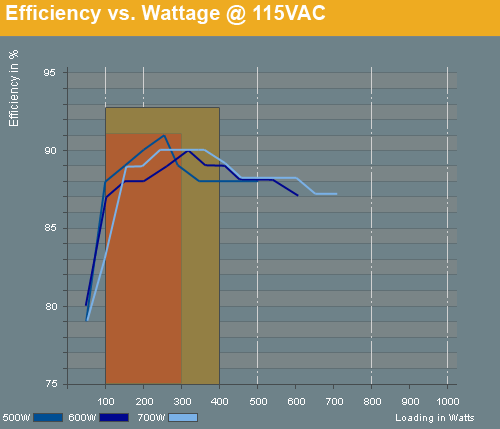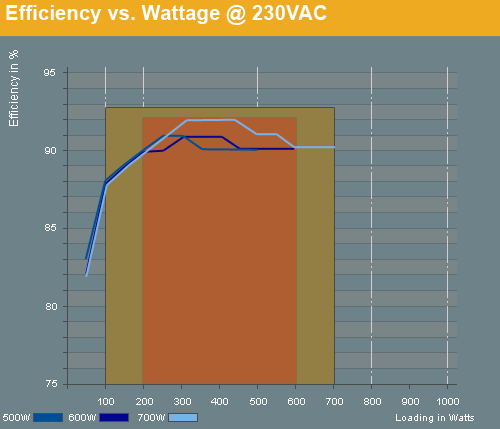Enermax Gold: Modu87+ and Pro87+
by Christoph Katzer on January 19, 2010 1:00 PM EST- Posted in
- Cases/Cooling/PSUs
Efficiency Comparison and How to Choose Your PSU
We wanted to explain to you how much power your system should actually use so you can make the best use of your new power supply. Of course you can load these power supplies up to the limit and still have around 87% efficiency - a result that many cheaper power supplies cannot reach even at their ideal load. However, these graphs show you where these power supplies reach their best efficiency.

From 100 to around 400W you will get maximum efficiency if you're on a 115VAC grid. That will provide you with an 88-91-88-percent curve with the 500W unit, an 87-90-89-percent curve with the 600W unit, and an 83-90-89-percent curve with the 700W unit. If you want even better efficiency you would want to be in the darker red area of 100 to 300W output. We've combined all three PSUs on one chart, however, so you will want to consider the curves and adjust your PSU selection as appropriate, e.g. the 700W PSU performs best with a load of at least 150W.

With 230VAC our recommendations look quite different. Users on a 230VAC grid can use any of these three units with any kind of load and achieve very good efficiency. Even at 5% load all of the units are still well above 80%, which is something that was difficult to reach a few years back. If you really want to squeeze the best results out of your units you will want load of at least 100W up to the maximum rated output of the PSU. That is a very large area and it shows how versatile these PSUs are. If your system uses 200W to 600W you will be able to maintain a constant efficiency of over 90%! In short, hook up just about any system to these power supplies on a 230V grid and you can be sure you'll be truly energy efficient.
Just to put things in perspective, the 80 Plus certification was introduced a few years back to put public focus on more energy efficient products, mainly power supplies. In the beginning there was only one certification, but since the initial introduction the group behind the certification has felt it necessary to introduce additional levels of efficiency. Today, we have Bronze, Silver, and Gold, with Gold being the highest level of the 80 Plus and presenting a very difficult target for the PSU manufacturers. The race to Gold has now been won, but now there's a new target in sight: Platinum. The required efficiencies for the different levels are listed below.
| 80 Plus Certification Requirements | |||
| 20% Load (Light) | 50% Load (Typical) | 100% Load (Full) | |
| 80 Plus Standard | 80% | 80% | 80% |
| 80 Plus Bronze | 82% | 85% | 82% |
| 80 Plus Silver | 85% | 88% | 85% |
| 80 Plus Gold | 87% | 90% | 87% |
| 80 Plus Platinum (230VAC only) | 90% | 94% | 91% |










59 Comments
View All Comments
rudolphna - Tuesday, January 19, 2010 - link
Very nice to see a new PSU review on anandtech, I was worried you guys had forgotten what made you popular- reviews of real products not just blog after blog. I have a suggestion, if I may. The Antec Neo Eco 400W power supply. I actually just bought one, it seems like a good deal. It has a 30 amp 12V rail (360W) a 120mm fan, and is 80plus certified. Not sure who the OEM for it is, I'm thinking Seasonic. But you guys should check it out. Great review by the way.papapapapapapapababy - Tuesday, January 19, 2010 - link
good luck finding a replacement for that gold monstrosity. so that make this crap a n buy for me. You see, i like to change the fans on my psu ( better fans) in order to control them myself.strikeback03 - Wednesday, January 20, 2010 - link
Might still use 140mm mounting holes, and just be a 139mm fan to avoid a stupid patent.Calin - Wednesday, January 20, 2010 - link
Hard to think you'll need a fan better than that - 50 Celsius for the vented air and almost totally silent even at maximum load?I have an old Seasonic 350W (12 cm fan) which I felt was totally silent in typical operation (closed case, computer under desk), and after about four years it still is totally silent.
papapapapapapapababy - Wednesday, January 20, 2010 - link
is not hard to think _ for me_ the big fan dsnt follow a standard, it has no other use for me, if a buy 4 120 fans i could give the multiple uses/ ( psu replacement fan, case fan, cpu fan, low speed fan, high speed fan, etc, - btw cases with big fans are terrible) one huge big ass fan? no other user ¡ difficult to find = no thanks.papapapapapapapababy - Wednesday, January 20, 2010 - link
is not hard to think _ for me_ the big fan dsnt follow a standard, it has no other use for me, if a buy 4 120 fans i could give the multiple uses/ ( psu replacement fan, case fan, cpu fan, low speed fan, high speed fan, etc, - btw cases with big fans are terrible) one huge big ass fan? no other user ¡ difficult to find = no thanks.Voldenuit - Tuesday, January 19, 2010 - link
Why use such a cumbersome term as Cable Management (which refers primarily to the neatness of cable routing) when 'Modular' is much more apt (and specifically referred to in the product name)?Nobody makes 'cable management' PSUs, but quite a few companies make 'modular PSUs'.
Mumrik - Tuesday, January 19, 2010 - link
More comparisons (especially in the benchmarking) to competing products (rather than just the other two in the series) would really be nice. I actually have come to expect it at Anandtech.To me, this came off as a bit more of a fluff piece. Not a disguised commercial but more like something I'd find at most other hardware sites.
ap90033 - Friday, January 22, 2010 - link
I thought this was a good article on specific hardware. But then again I am not the uber geek with no life like some seem to be around here....RaistlinZ - Tuesday, January 19, 2010 - link
Geez, and I thought the X-Series was overpriced. Sure, these Enermax PSU's are efficient, but certainly not $50.00 more efficient than say, an Corsair 750HX. If they come with a $30.00 MIR then they might be worth the money, but otherwise I'll pass.